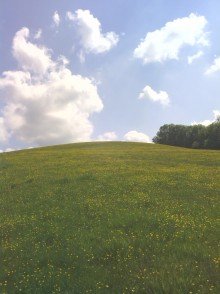We had already decided that we would chicken out of the walk up the ridiculously steep sides of Hod Hill and instead enjoy a leisurely stroll along the banks of the River Stour. This proved to be a wise decision with the grasses out in full flower on the hill making it a no-go area for any hay-fever sufferer like myself.
The recent rain had made the path by the river quite muddy but the same rain had also brought on a veritable flood of flowers. We saw Stinking Iris stems larger than any we had seen before and the Common Hogweed here was truly gigantic proportions, some stems as high as seven feet! We were careful to check that it wasn’t the true Giant Hogweed though as to sensitive skins just a brush from that plant would be enough to burn the skin.
Pausing to look across the river we saw huge flat lily pads buzzing with impossibly bright blue Banded Demoiselles, brighter than any we had seen before. An unfamiliar damselfly that appeared much closer to us turned out to be a female Large Red Damselfly, but of a scarce dark-coloured form.
The real star here though was a family of Mandarin Ducks, nervously edging along the far bank of the river. This duck nests in holes in trees and is never found far from woodland. It was originally introduced from China but now breeds in many locations in the UK. In fact, the original Chinese population is now endangered and our feral birds may be of international importance.
Now the path turns eastward and leaves the river to cross a maize field under the hill. This ancient track, known as Hod Drive, leads to nearby Stourpaine. Today it was full of wild flowers, with many types of beetles, flies and other insects, including the aptly-named Swollen-thighed Beetle! One of the most colourful was a gorgeous red and black Cinnabar Moth, its colours warning the local birds that it is loaded with poisons collected a year ago when it was a larva feeding on Ragwort.
See the links below for the relevant pages on iSpot, where the more doubtful identifications will hopefully be confirmed.
Birds
Buzzard
Kestrel
Mandarin Duck
Pheasant
Goldcrest (heard)
Chiffchaff (heard)
Whitethroat
Robin
Insects
Speckled Wood
Red Admiral
Small White
Cinnabar moth (see https://www.ispot.org.uk/node/271498)
Banded Demoiselle
Large Red Damselfly (see https://www.ispot.org.uk/node/271493)
Longhorn Beetle
Click Beetle
Swollen-thighed Beetle
Hoverfly (Helophilus pendulus) (see https://www.ispot.org.uk/node/271494)
Yellow Dungfly (see https://www.ispot.org.uk/node/271500)
Unidentified Fly (see https://www.ispot.org.uk/node/271503)
Plants
Common Hogweed Wood Anemone
Yellow Water-lily
Herb Bennet
Hedge Woundwort (see https://www.ispot.org.uk/node/271497)
Wild Garlic (Ramsons)
Stinking Iris (see https://www.ispot.org.uk/node/271495)
Wood Melick?
Hairy Brome?
Pendulous Sedge
Hart’s Tongue Fern







